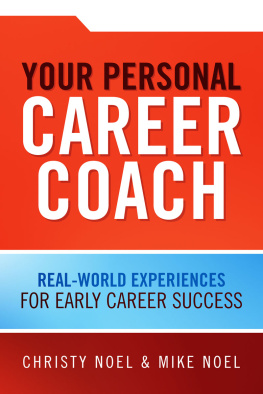Copyright 2020 by Ed Evarts
All rights reserved. No part of this book may be reproduced, stored in a retrieval system or transmitted, in any form or by any means, without the prior written consent of the publisher or a licence from The Canadian Copyright Licensing Agency (Access Copyright). For a copyright licence, visit www.accesscopyright.ca or call toll-free to 1-800-893-5777.
Some names and identifying details have been changed to protect the privacy of individuals.
ISBN 978-1-7345004-0-0 (paperback)
ISBN 978-1-7345004-1-7 (ebook)
Published by Excellius Press
www.excellius.com
Produced by Page Two
www.pagetwo.com
Cover and interior design by Taysia Louie
Ebook by BrightWing Media
www.excellius.com
Introduction
W hat can I do about my performance issues, Ed?
The question came from one of my leadership coaching clients, a medical director at a large technology company with offices in the Boston area. Ill call him Kevin.
Kevins question is one I hear a lot, and I mean a lot, from the clients I see as a leadership coach. In Kevins case, his performance issues had to do with his difficulties speaking up at senior-level meetings and his fast work pace, which made it hard for others to be engaged on teams with him and to work with him one on one.
As a coach, my goal is to help clients like Kevin answer their performance questions for themselves. In some cases, though, my clients need more of a coach-sultanta coach who, with the clients permission, can put on the hat of a consultant and answer non-coaching questions directly. Such was the case with Kevin.
Id be happy to answer that question, I replied. First, I need your permission to stop being a coach and start being a consultant. What kind of help do you need right now?
I need a consultant! Kevin quickly exclaimed.
Okay, I said. Here are a few ideas that I share with many of my clients. I believe theyll help you too.
Kevin listened intently to what I had to say about the behaviors and actions that I felt would help him, and he left our meeting more energized than Id seen him for a long time.
I was struck by how excited Kevin was to hear the handful of simple ideas Id shared, and I began to think about the other advice I frequently offer. Within minutes, a short list emerged of the behaviors and actions that have helped so many of my clients become the drivers of their careers.
Ive met a lot of people in my thirty-five-year business career, which has included twelve years as a leadership coach. Some of my clients are drivers and some are passengers. Passengers are along for the ride, not caring where they end up. Drivers care. Drivers have a vision for their career; they take responsibility for their success; and they make purposeful decisions to get from point A to point B.
My goal with this book is to help you become the driver of your career and make positive progress at work.
My goal with this book is to help you become the driver of your career and make positive progress at work.
When I started to tell colleagues that a simple set of behaviors and actions can help everyone, many reacted with disbelief. Back when I began working as a coach, I would have agreed with their conclusion. Now that Ive been coaching business leaders for over twelve years, though, Ive seen firsthand how remarkably consistent my clients needs are. While the specifics of each clients situation are unique to them, at the core of addressing many work-related issues are common behaviors and actions that, if practiced regularly, can help anyone make progress in their organization, earn the respect of their co-workers, and be more productive and happier at work.
When I say anyone can benefit from the nine simple ideas in this book, I really do mean it. As you read, youll see that:
The ideas are industry-agnostic. Whether you are in pharmaceuticals, law, finance, engineering, or any other industry, you can implement these ideas at any time.
The ideas are role-agnostic. Whether you are an entry-level employee, a manager, a director, a vice president, or a president, all of these ideas apply to you.
Here are a few other things to keep in mind as you read:
While you may not need to implement all nine ideas, you likely need to apply many of them. Chances are you already have incredibly busy workdays, and adopting many new behaviors and actions at once may not be possible. Thats okay. You can try out a few ideas at a time, or rotate them. As long as youre implementing some of them, youll be better off in your work experience than you are now.
The ideas are not presented in order of importance. I have no desire to tell you which ideas are more important for you than others. You will be the best judge of what you need to do to be more successful at work. As I say in idea #2, no one knows you better than you do.
Doing something recurrently matters more than doing it frequently. When you start adopting new behaviors and actions, applying them recurrentlythat is, at regular intervalsis more important than applying them frequently. Many of my clients initially feel that when it comes to a new behavior, more is better. In truth, more is not better if you cant keep it up.
Sounds simple, right? Well, the reality is that even though these nine ideas are simple on the surface, it takes sustained effort and focus to put them into practice. Thats why youre reading this book!
Each chapter of this book explores one of the nine ideas. The chapter covers what might be stopping you from implementing the idea, and shares tips that have helped my coaching clients put certain behaviors and actions into regular practice to achieve real results. You can read straight through the book or dip in anywhere to find the inspiration that applies most to you at any moment in your career. Throughout, key phrases that I believe you need to remember are highlighted.
Okay. Are you ready to learn more about the nine ideas that Ive shared with most of my clients, most often, to make a difference in their career?
Wait! This sentence reminds me to pause and acknowledge that what Im about to share with you is advice as opposed to opinion. An opinion reflects what someone thinks, regardless of how accurate the basis of their opinion may be, or their interpretation of the facts. My belief on gun control, for example, is an opinion. Advice reflects what someone thinks and has experienced based on the time they have spent in an area of practice and the knowledge they have gained. For example, behaviors that your doctor tells you to follow are advice. Your doctors recommendations and prescriptions are based on knowledge and experience, not opinion.
Doing something recurrently matters more than doing it frequently.
Advice is more important than opinion. This book contains advice. The behaviors and actions you will read about are things that many people in organizations around the globe can and should do to improve their work experience. Im confident that if you try to follow my advice and take responsibility for your own success, youll improve your work experience too.
Ready to become the driver of your career? Lets get started.
R adhanath is a successful businessperson who has a terrific relationship with his boss, Ted. Ever since Ted hired him, Radhanath has made impressive progress in the organization, with two promotions and regular generous pay increases. I dont think you know how brilliant you are, Ted tells Radhanath one day. Radhanaths career prospects seem limitless.
To Radhanaths surprise, everything changes when Ted decides to leave and a new boss, Victor, steps in. Victor is very different from Ted. Victor and Radhanath do not see things eye to eye, the way Ted and Radhanath did in the past. Radhanaths share of interesting projects and high-profile assignments drops off. Victor does not seem to trust Radhanath, nor does he promote him or reward him with generous raises.
Next page








